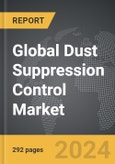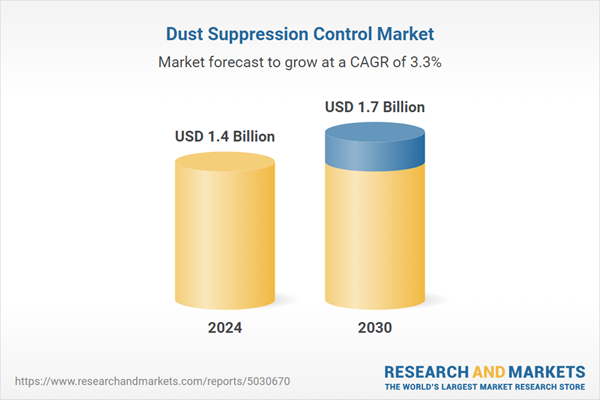Global Dust Suppression Control Market - Key Trends & Drivers Summarized
Why Is Dust Suppression Control Essential in Industrial Operations?
Dust suppression control has become a critical aspect of various industries such as mining, construction, agriculture, and manufacturing due to its significant impact on environmental compliance and worker safety. Dust, when not managed properly, can lead to hazardous working conditions, reduce visibility, damage machinery, and cause severe respiratory health issues. As a result, industries are increasingly adopting advanced dust suppression techniques and technologies to mitigate these risks. Techniques like water spraying, chemical suppressants, and foam systems are commonly used to control dust emissions at their source, ensuring adherence to regulatory standards and enhancing operational efficiency. Additionally, the need to control fugitive dust emissions to minimize the environmental impact has further underscored the importance of effective dust suppression strategies.How Are Innovations and Technological Advancements Impacting the Dust Suppression Control Market?
The dust suppression control market is witnessing significant growth due to technological innovations aimed at improving efficiency and sustainability. The development of automated systems that utilize sensors and smart technology allows for real-time monitoring and precise application of dust suppressants, optimizing their use while minimizing water and chemical consumption. Environmentally-friendly suppressants made from biodegradable materials are gaining popularity, aligning with global trends towards sustainability and reduced environmental impact. Additionally, industries are increasingly adopting dust suppression solutions that integrate with their existing operational processes, allowing for seamless and cost-effective implementation. Mobile dust control systems and drone-based spraying technologies are also emerging trends, providing flexibility and efficiency in dust management, especially in challenging and expansive industrial environments.What Role Do Regulations and Environmental Concerns Play?
Regulatory requirements are a major driver in the adoption of dust suppression control measures. Governments worldwide have set stringent emissions and air quality standards to reduce particulate matter pollution, which is a significant contributor to health and environmental issues. Compliance with regulations such as those set by the Environmental Protection Agency (EPA) in the U.S., or similar bodies in other regions, necessitates the implementation of effective dust control strategies. In addition to regulatory pressure, there is a growing focus on sustainable practices and minimizing the environmental footprint of industrial operations. Companies are therefore adopting green dust control solutions, such as organic and biodegradable suppressants, to align with environmental policies and consumer expectations for eco-friendly practices. This shift not only aids in regulatory compliance but also enhances corporate social responsibility and brand image.What Is Driving the Growth of the Dust Suppression Control Market?
The growth in the dust suppression control market is driven by several factors, including the increasing enforcement of stringent air quality regulations, the expansion of industrial activities, and the rising focus on worker health and safety. Industries such as mining, construction, and manufacturing are expanding globally, necessitating efficient dust management solutions to comply with safety and environmental standards. Furthermore, advancements in technology, such as smart dust suppression systems that optimize water and suppressant usage, are gaining traction as they offer operational efficiency and cost-effectiveness. The demand for eco-friendly suppressants is also growing, as industries aim to reduce their environmental impact and align with sustainability initiatives. As companies strive to enhance operational safety and efficiency, the market for dust suppression control continues to expand, providing innovative and effective solutions for diverse industrial applications.Report Scope
The report analyzes the Dust Suppression Control market, presented in terms of market value (USD Thousand). The analysis covers the key segments and geographic regions outlined below.Segments
Product (Wet Type, Dry Type).Geographic Regions/Countries
World; United States; Canada; Japan; China; Europe (France; Germany; Italy; United Kingdom; Spain; Russia; and Rest of Europe); Asia-Pacific (Australia; India; South Korea; and Rest of Asia-Pacific); Latin America (Argentina; Brazil; Mexico; and Rest of Latin America); Middle East (Iran; Israel; Saudi Arabia; United Arab Emirates; and Rest of Middle East); and Africa.Key Insights:
- Market Growth: Understand the significant growth trajectory of the Wet Type Dust Suppression Control segment, which is expected to reach $1.3 Billion by 2030 with a CAGR of a 3.4%. The Dry Type Dust Suppression Control segment is also set to grow at 2.9% CAGR over the analysis period.
- Regional Analysis: Gain insights into the U.S. market, valued at $369.7 Million in 2024, and China, forecasted to grow at an impressive 5.4% CAGR to reach $335.1 Million by 2030. Discover growth trends in other key regions, including Japan, Canada, Germany, and the Asia-Pacific.
Report Features:
- Comprehensive Market Data: Independent analysis of annual sales and market forecasts in USD from 2024 to 2030.
- In-Depth Regional Analysis: Detailed insights into key markets, including the U.S., China, Japan, Canada, Europe, Asia-Pacific, Latin America, Middle East, and Africa.
- Company Profiles: Coverage of major players such as Applied Conveyor Technology Inc. DBA The ACT Group, Archer Daniels Midland Company, BASF SE, Benetech, Inc., Borregaard AsA and more.
- Complimentary Updates: Receive free report updates for one year to keep you informed of the latest market developments.
Why You Should Buy This Report:
- Detailed Market Analysis: Access a thorough analysis of the Global Dust Suppression Control Market, covering all major geographic regions and market segments.
- Competitive Insights: Get an overview of the competitive landscape, including the market presence of major players across different geographies.
- Future Trends and Drivers: Understand the key trends and drivers shaping the future of the Global Dust Suppression Control Market.
- Actionable Insights: Benefit from actionable insights that can help you identify new revenue opportunities and make strategic business decisions.
Key Questions Answered:
- How is the Global Dust Suppression Control Market expected to evolve by 2030?
- What are the main drivers and restraints affecting the market?
- Which market segments will grow the most over the forecast period?
- How will market shares for different regions and segments change by 2030?
- Who are the leading players in the market, and what are their prospects?
Some of the 38 major companies featured in this Dust Suppression Control market report include:
- Applied Conveyor Technology Inc. DBA The ACT Group
- Archer Daniels Midland Company
- BASF SE
- Benetech, Inc.
- Borregaard AsA
- Cargill, Inc.
- Dow, Inc.
- DuPont de Nemours, Inc.
- Global Road Technology International Ltd.
- Huntsman International LLC
- Quaker Chemical Corporation
- Reynolds Soil Technologies Pty Ltd
- SAMI Bitumen Technologies
- SUEZ North America
Table of Contents
Companies Mentioned (Partial List)
A selection of companies mentioned in this report includes, but is not limited to:
- Applied Conveyor Technology Inc. DBA The ACT Group
- Archer Daniels Midland Company
- BASF SE
- Benetech, Inc.
- Borregaard AsA
- Cargill, Inc.
- Dow, Inc.
- DuPont de Nemours, Inc.
- Global Road Technology International Ltd.
- Huntsman International LLC
- Quaker Chemical Corporation
- Reynolds Soil Technologies Pty Ltd
- SAMI Bitumen Technologies
- SUEZ North America
Table Information
| Report Attribute | Details |
|---|---|
| No. of Pages | 292 |
| Published | April 2025 |
| Forecast Period | 2024 - 2030 |
| Estimated Market Value ( USD | $ 1.4 Billion |
| Forecasted Market Value ( USD | $ 1.7 Billion |
| Compound Annual Growth Rate | 3.3% |
| Regions Covered | Global |









